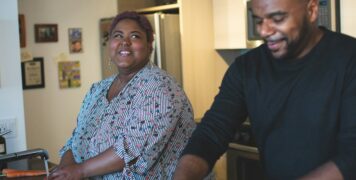Contact
020 4515 6728
info@ccameron.co.uk
Charles Cameron & Associates
Blackfriars Foundry
154-156 Blackfriars Road
London SE1 8EN
Are you ready to become a Buy-To-Let landlord?
May 17, 2021
Information published was correct at the time of writing
--

You can become a landlord in many different ways. Perhaps you have inherited a property that you want to keep but not to live in or maybe you have your eye on a property that you wish to acquire with a view to rent out. There are an estimated 3 million buy-to-let landlords in the UK who choose to invest in property for long-term capital growth, but also want to make money in the short term from rental income. If you are considering becoming a buy-to-let landlord, here are a few things you need to know.
Being a buy-to-let landlord comes with a fair number of obligations and responsibilities. These include tenancy agreements, tenancy deposits, repair and maintenance and more.
Why do people become Buy-To-Let landlords?
People may have their own reasons, but typically, buy-to-let is an investment. While some people invest their money in the stock markets, others choose to invest in property, which requires different knowledge and skills. Choosing to become a landlord is a big decision, with great benefits as well as an array of challenges that need to be considered. It’s a big responsibility, whether you own one property or several, so gaining some insight into what you can expect is essential.
How do Buy-To-Let landlords make money?
As a buy-to-let investor, you will either be relying on capital growth (increase in the value of the property over the medium to long term) or rental yield (income generated from the property expressed as a percentage of the property value). You’ll need to work out which of these has the greater advantage.
Rental yield – the money you make from the rent you charge to tenants. You’ll need to pay income tax on this money.
Capital growth – money you make by selling the property at a higher price than you paid for it. You’ll need to pay capital gains tax on this money.
How do you find a Buy-To-Let property?
You can start to search in the same way as you would search for a home for yourself – by speaking to estate agents and searching online. The features you look for in the property will probably be different to what you’d look for in your own home, and this depends on whom you plan to let to – a decision you should make before buying. Different demographics have different requirements. For example, students want properties in cheap but vibrant areas with good public transport links to university. Professional sharers often look for equally proportioned bedrooms. Families need good local schools and safe roads. If you plan to rent to multiple people in one property, you also need to be aware of the government’s rules around houses in multiple occupation as there are certain requirements, like bedrooms of particular sizes. Once you’ve found the right property, you’ll need a buy-to-let mortgage.
What is a Buy-To-Let mortgage?
If you can’t buy your investment property outright, you’ll need to apply for a mortgage. There are specific mortgages on offer for people who plan to let out their property, and unsurprisingly, these are called buy-to-let mortgages, or BTL mortgages. In many ways they are like regular mortgages and have a similar application process: you’ll need a good credit rating together with a suitable deposit and you’ll usually apply for an Agreement in Principle before you put in an offer on a property.
Important ways that Buy-To-Let mortgage are different
There are various differences between a residential and a buy-to-let mortgage, and they start with the way your affordability is calculated.
Important ways that Buy-To-Let mortgage are different
There are various differences between a residential and a buy-to-let mortgage, and they start with the way your affordability is calculated.
• You’ll probably need a bigger deposit (usually between 25% and 40% of the property value)
• You’ll normally only pay off the interest each month, not the capital. That means you’ll need to pay off the capital at the end of the mortgage term. Sometimes landlords will sell the property to do this, or you can use other funds to pay it off.
• They usually have higher fees than mortgages for owner-occupiers
• The interest rates are also often higher
• The eligibility requirements can be stricter
Who can get a Buy-To-Let mortgage?
You’ll usually need to own a home of your own already (including a home you have a mortgage on). Like most other loans, your finances need to be in order. You’ll need a good credit record, and usually a regular income of £25,000 or more.
How is my interest rate calculated?
The rate you’re offered may be influenced by several factors, including:
• The type of rental property you have (e.g. long-term rental, or short-term holiday let)
• Whether you choose a variable or fixed-rate mortgage
• The value of the property you’re using to secure the mortgage
• How much you need to borrow (both in total and as a percentage of your property’s value)
• Your credit history (but not your credit score)
Location, Location, Location
Finding the right property in the right location is important when searching for your own home. But it’s equally important when looking for a buy-to-let property. So, before you start your search, think about what kind of tenant you are targeting. If you get the location or type of property wrong, you’ll find yourself in a situation where the rent you charge will need to be lower and the right tenants harder to come by.
Many lenders have restrictions on mortgages for student lets and Houses in Multiple Occupation (HMOs). So the type of tenant renting your property can really impact your plans. For instance, an HMO building is defined by having three tenants or more, that form more than one household and who share a toilet, bathroom or kitchen facilities. Some properties may also be more difficult to secure a mortgage on, so you need to bear this in mind. These can include former council houses, new developments and flats above commercial premises, such as shops.
Are you ready to become a Buy-To-Let landlord?
Ask yourself these questions to help decide if this is right for you:
• Are you interested in property, and keen to invest your money here rather than in the stock markets?
• Are you willing to put some time into the process in exchange for the potential
financial reward?
• Might you enjoy the process of property hunting and home improvement?
• Are you confident working with numbers and calculating things like rental yield?
• Do you understand that – like with any investment – there is risk involved, and there can be unexpected costs?
If your answers are ‘YES’, you’re probably ready to take the next step
Despite the UK Government continuing to introduce policies aimed at making it difficult for buy-to-let landlords to make significant profits if approached in the right way buy-to-let can still be an attractive investment opportunity for anyone who is able to purchase a second home, or build a portfolio, and rent their properties out to tenants.



